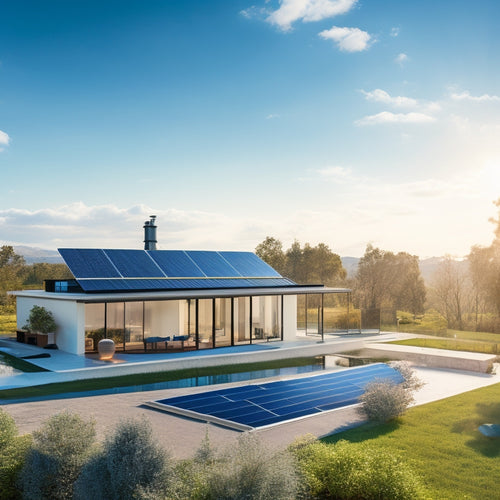
5 Best Car Battery Maintenance Tips for Eco Drivers
Share
You're committed to minimizing your environmental impact, and proper car battery maintenance is a great place to start. Begin by monitoring your battery's state, checking voltage, and tracking its performance. Avoid deep discharging cycles, as they can cause irreversible damage. Keep your terminals clean and tight, and charge your battery correctly to prevent overheating. Regularly inspect your electrolyte levels and top them off as needed. By following these expert-approved tips, you'll extend your battery's lifespan and reduce waste - and there's more to learn about optimizing your eco-friendly driving habits.
Key Takeaways
• Regularly check battery state, including charge, voltage, and electrolyte levels, to identify potential issues proactively.
• Avoid deep discharging cycles by maintaining a charge above 50% to preserve battery health and extend its lifespan.
• Ensure clean and tight terminals by removing corrosion, applying terminal protectors, and regularly checking and tightening connections.
• Charge your battery correctly by following the recommended charging speed for your battery age and preventing under/overcharging.
• Inspect electrolyte levels regularly, wearing protective gear, and top off with distilled water if levels are low to prevent corrosion and damage.
Monitor Your Battery's State
Regularly check your car battery's state of charge, voltage, and electrolyte level to identify potential issues before they leave you stranded. This proactive approach will help you detect minor problems before they escalate into major headaches.
You'll want to keep a close eye on your battery's voltage, as a sudden drop can be a sign of a failing battery. Set up voltage alerts to notify you when the voltage dips below a certain threshold, ensuring you address the issue promptly.
Additionally, consider investing in a battery logger to track your battery's performance over time. This device will provide valuable insights into your battery's behavior, helping you identify patterns and trends that may indicate a problem.
By monitoring your battery's state, you'll be well-equipped to tackle any issues that arise, ensuring your car remains reliable and environmentally friendly.
Avoid Deep Discharging Cycles
Deep discharging cycles can silently drain your car's battery, causing irreversible damage and reducing its overall lifespan, so it's important you take steps to avoid them.
When you let your battery deeply discharge, you're essentially shortening its cycle life. A cycle life refers to the number of charge and discharge cycles a battery can handle before its capacity starts to degrade. The more you deep discharge your battery, the fewer cycles it can handle, ultimately affecting its overall battery health.
To avoid deep discharging, make it a habit to keep your battery charged above 50% whenever possible. You can do this by taking shorter trips, turning off unnecessary accessories when the engine is off, and avoiding extreme temperatures. Additionally, consider investing in a high-quality battery maintainer or trickle charger to keep your battery topped up when not in use.
Keep Terminals Clean and Tight
Since you're already taking steps to avoid deep discharging, it's equally important to make sure your battery terminals are clean and tight to maintain a reliable connection and prevent corrosion. Corrosion can lead to Terminal Corrosion, which weakens the connection and reduces the battery's overall performance.
To keep your terminals clean, use a wire brush to remove any corrosion or buildup. Apply a terminal protector or petroleum jelly to prevent future corrosion.
Tightening your terminals ensures a secure Connection Type, which is vital for efficient energy transfer. Make sure to check your terminals regularly, as loose connections can cause energy loss and decreased performance.
When tightening, be careful not to overtighten, as this can damage the terminals or battery posts. By keeping your terminals clean and tight, you'll secure a reliable connection and prolong the life of your battery.
Charge Your Battery Correctly
You need to recharge your car battery correctly to prevent undercharging or overcharging, which can greatly reduce its lifespan. As an eco-friendly driver, it's crucial to understand the best charging speed for your battery. A slow charging speed is recommended, especially for older batteries, to prevent overheating and damage.
Here's a charging guide to keep in mind:
| Battery Age | Charging Speed | Recommended Time |
|---|---|---|
| New (0-1 year) | Fast (1-2 hours) | 1-2 hours |
| Medium (1-3 years) | Medium (2-4 hours) | 2-4 hours |
| Old (3+ years) | Slow (4-6 hours) | 4-6 hours |
Check Electrolyte Levels Regularly
Regularly inspecting your car battery's electrolyte levels can help prevent damage and prolong its lifespan. You'll want to check the electrolyte composition, ensuring it's within the recommended specifications. Electrolyte levels that are too low or too high can cause corrosion, reducing your battery's overall performance.
When inspecting the electrolyte levels, make sure to wear protective gloves and safety glasses. Locate the battery's maintenance caps, usually found on top of the battery. Remove the caps and take a peek inside. You'll see the electrolyte solution, which should be around 1-2 inches above the plates.
If the levels are low, you can top them off with distilled water. However, be cautious not to overfill, as this can cause more harm than good. Remember, water quality is important, so use distilled water to prevent mineral buildup.
Frequently Asked Questions
Can I Use Any Charger for My Eco-Friendly Car Battery?
You shouldn't use just any charger for your eco-friendly car battery; guarantee compatibility by checking the manufacturer's recommendations to avoid battery damage or safety risks, prioritizing battery safety and peak performance.
How Often Should I Add Distilled Water to My Battery?
Did you know 75% of car batteries die prematurely due to lack of maintenance? You should check and top off your battery's distilled water levels every 3-6 months, ensuring water quality to maintain peak battery health.
Do I Need to Replace My Battery if It's Over Three Years Old?
You shouldn't necessarily replace your battery at three years, but its lifespan depends on age factors like usage, climate, and maintenance. Assess its condition and performance before deciding to replace it.
Can I Jump-Start My Eco-Car With a Non-Eco Car?
When you're stranded, it's tempting to jump-start your eco-car with a non-eco car, but beware: Hybrid Incompatibility risks damage. Prioritize Jump Start Safety; instead, call a tow truck or roadside assistance for a safe, compatible boost.
Are All Eco-Friendly Car Batteries Maintenance-Free?
You'll be relieved to know that not all eco-friendly car batteries are maintenance-free, despite meeting strict Eco Standards. However, recent Battery Innovations have made maintenance a whole lot easier, giving you more time to focus on your eco-friendly lifestyle.
Related Posts
-

Why Recharge Your Car Battery With DIY Power?
By switching to DIY solar power, you can drastically reduce your reliance on expensive battery services, lower your c...
-

Why Opt for High-Efficiency Solar Panels Online?
You can greatly enhance your solar energy output and savings by upgrading to high-efficiency solar panels, which can ...
-

5 Best Online Stores for Green Vehicle Solutions
You're on the hunt for an eco-friendly ride, and online stores are a great place to start. You'll find top retailers ...


